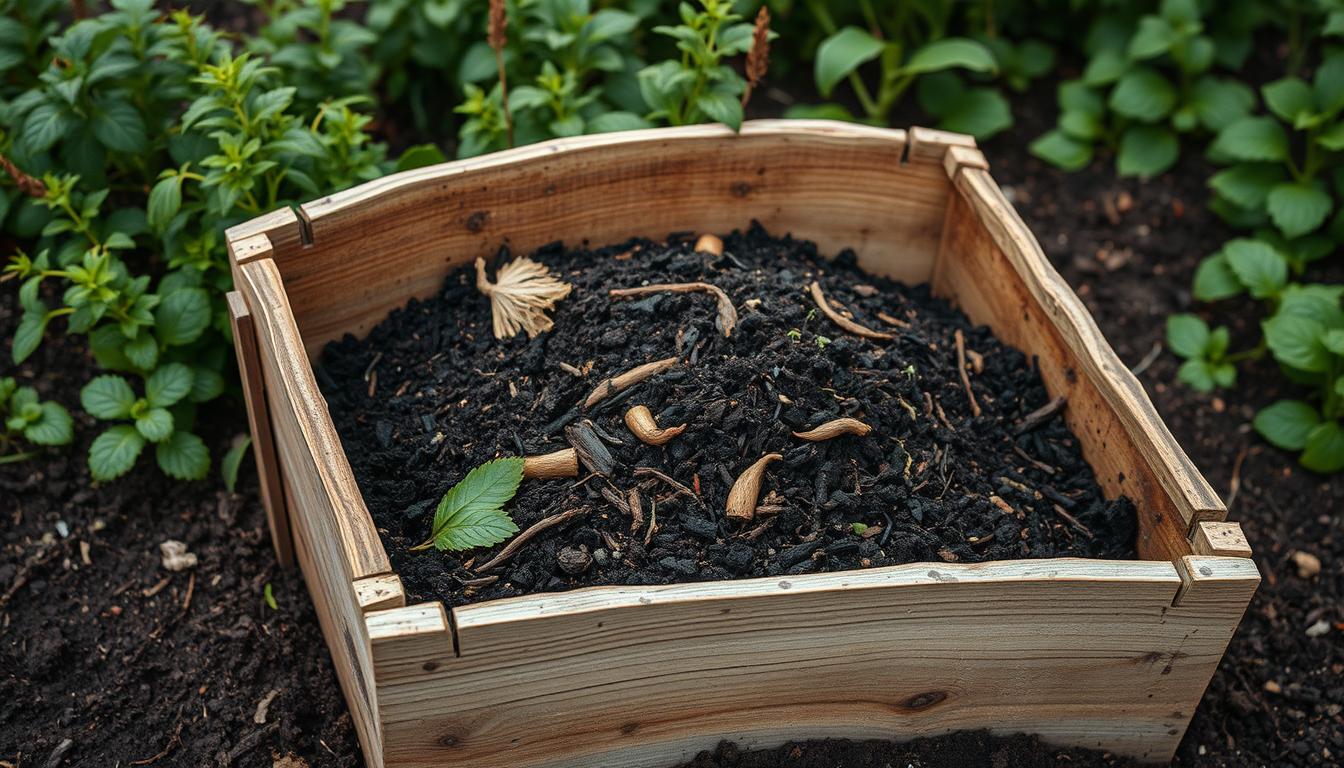Turning kitchen scraps and yard waste into rich, dark soil might seem like magic. But it’s just nature’s recycling system at work. Organic composting creates a valuable resource for your garden while keeping waste out of landfills.
When you start composting, you join a community of gardeners who embrace sustainable practices. The finished compost adds essential nutrients to your soil. It improves its structure and helps it retain moisture – all without chemical fertilizers.
Plants grown in compost-enriched soil typically produce higher yields. They also show better resistance to pests and diseases. This natural approach to soil health forms the foundation of eco-friendly gardening practices. It benefits both your plants and the planet.
Beyond the practical benefits, there’s something deeply satisfying about completing the garden cycle. You nurture plants, enjoy their harvests, compost their remains, and use that compost to grow new plants. It’s a simple yet powerful way to connect with the natural world right in your backyard.
The Natural Cycle of Decomposition in Your Backyard
Your backyard is a living lab where decomposition turns old waste into garden gold. Organic composting taps into a billion-year-old recycling system. It turns dead plants, kitchen scraps, and yard waste into nutrient-rich compost.
Understanding the Biological Process
Decomposition is more than just rotting. It’s a biological symphony. Earthworms, beetles, and millipedes start by breaking down materials. This makes more surface area for microorganisms.
Bacteria come next, multiplying fast and creating heat. This heat, up to 150°F, shows your compost is working. Scientists call this the thermophilic phase, powerful enough to kill weed seeds and pathogens.
Then, fungi and actinomycetes take over. They break down tough substances like cellulose and lignin. This cooler phase creates stable humus, the dark, crumbly material that gives compost its earthy smell and remarkable properties.
How Nature Recycles Nutrients
Walk through any forest and you’ll see little waste. Nature recycles perfectly. Leaves fall, animals die, and all return to the soil, feeding new plants.
Your compost pile works like a forest floor but faster. By controlling moisture, aeration, and material mix, you speed up the process. This way, you can get compost in weeks or months, much faster than nature.
| Decomposition Stage | Primary Organisms | Temperature | Timeframe |
|---|---|---|---|
| Initial Breakdown | Insects, worms | Ambient | Days |
| Active Heating | Thermophilic bacteria | 120-150°F | 1-3 weeks |
| Cooling Phase | Fungi, actinomycetes | 80-100°F | Several weeks |
| Maturation | Diverse microbes | Ambient | 1-3 months |
Through this cycle, essential nutrients like nitrogen, phosphorus, and potassium become available to plants. Organic composting delivers these nutrients in balanced forms. These nutrients release slowly, exactly as plants have evolved to use them.
Why Organic Composting Is Essential for Sustainable Gardening
Organic composting is more than just for plants. It’s a key step towards living more sustainably. By composting, gardeners join a natural cycle that helps the planet. It turns kitchen scraps and yard waste into something good for the earth.
Reducing Landfill Waste
Did you know food scraps and yard waste make up nearly 30% of what Americans throw away? When sent to landfills, they break down slowly, producing methane. This gas is 25 times more potent than carbon dioxide.
Composting at home can divert hundreds of pounds of waste from landfills each year. It’s a simple way to reduce waste and turn it into something useful for your garden.
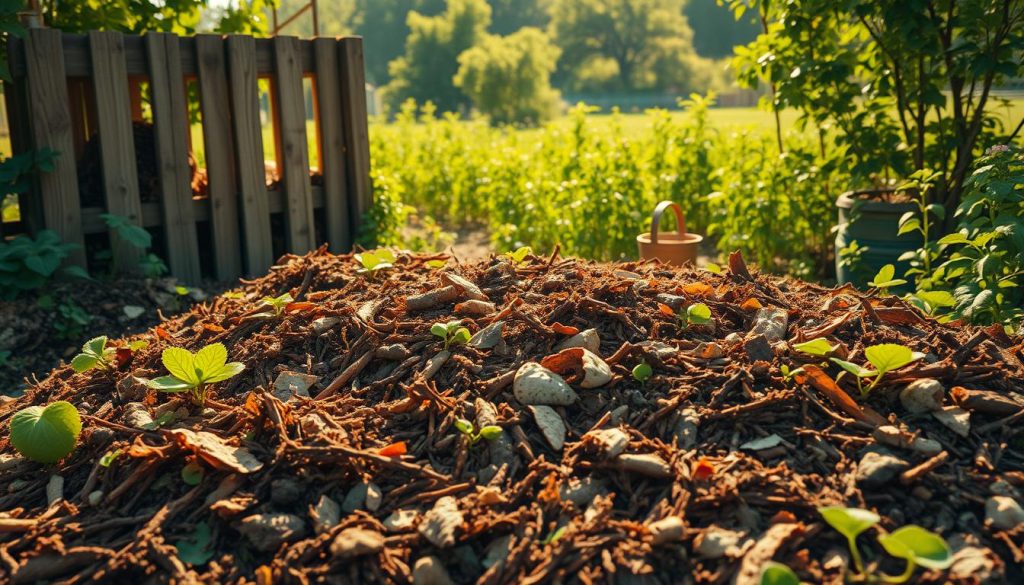
Decreasing Carbon Footprint
Composting is good for the climate. It reduces methane emissions compared to landfills. Plus, compost helps soil lock away carbon from the atmosphere.
Using homemade compost also cuts down on synthetic fertilizers. These fertilizers need a lot of energy to make and transport. Switching to compost reduces your garden’s carbon footprint.
Conserving Water Resources
Compost-enriched soil holds moisture well. This can cut water needs by up to 30% compared to poor soil. It’s a big water saver for gardens.
Compost acts like a sponge, keeping moisture near roots. This is crucial in areas with water restrictions or during dry seasons. It’s a key tool for gardening sustainably.
Regular composting also creates a loose, rich soil. This encourages deeper root growth. Plants become more drought-resistant, needing less water.
Transforming Kitchen Scraps Into Garden Gold
Turning kitchen waste into compost is very rewarding. That banana peel or carrot tops from dinner aren’t trash. They’re valuable for your garden. Just use a kitchen scraps container to collect them.
The process is simple, but the benefits are huge. Your plants get natural nutrients, you cut down on waste, and you help your garden grow.
Suitable Food Waste for Composting
Not all kitchen waste is good for composting. Some scraps break down well and add nutrients, while others can cause problems.
Fruit and Vegetable Scraps
Fruit and veggie scraps are key for compost. Apple cores, potato peels, and salad greens decompose fast. They add moisture too. Chop big pieces before adding them.
Citrus peels are okay, but use them sparingly. They can change the compost’s pH. Banana peels are great because they add potassium, which helps plants grow.
Coffee Grounds and Tea Leaves
Coffee grounds and tea leaves are compost gold. Coffee grounds add nitrogen, which helps microbes grow. They also improve soil and attract worms.
Tea leaves do the same. You can even add paper tea bags, as long as they’re free from synthetic stuff. Both make your compost smell great.
Items to Avoid in Your Compost Bin
Some kitchen scraps shouldn’t go in your compost. Meat, dairy, and oily foods attract pests and smell bad. They also decompose slowly and can harm your compost.
| Compost These | Benefits | Avoid These | Problems Caused |
|---|---|---|---|
| Fruit & vegetable scraps | Quick decomposition, adds moisture | Meat & fish scraps | Attracts pests, creates odors |
| Coffee grounds & filters | Adds nitrogen, improves texture | Dairy products | Slow decomposition, attracts rodents |
| Eggshells (crushed) | Adds calcium, reduces acidity | Oils & fats | Creates water-resistant barriers |
| Tea bags & leaves | Adds nitrogen, attracts worms | Diseased plants | Spreads plant pathogens |
Choose what goes into your compost bin carefully. Use a small container in your kitchen for scraps. Soon, sorting waste will become second nature.
Yard Waste: A Valuable Resource for Your Compost Pile
Leaves, grass clippings, and pruned branches are not trash. They’re valuable resources for your compost pile. By recycling yard waste in your garden, you create a closed-loop system. This system reduces landfill waste and improves soil health.
Most homeowners have the perfect composting ingredients right outside their door. The average American yard produces hundreds of pounds of compostable material each year.
Balancing Green and Brown Materials
Successful composting needs the right mix of yard waste. You need nitrogen-rich “greens” and carbon-rich “browns.” This mix creates the best conditions for decomposition.
A good rule of thumb is to use one part green materials to three parts brown materials by volume. This balance prevents problems like bad smells or slow breakdown.
Nitrogen-Rich “Greens”
Fresh grass clippings are the perfect “green” material. They provide the nitrogen needed for microbial activity in your compost. Other valuable greens include fresh plant trimmings, young weeds, and spent annual flowers.
These materials break down quickly. They also generate the heat needed for active composting.
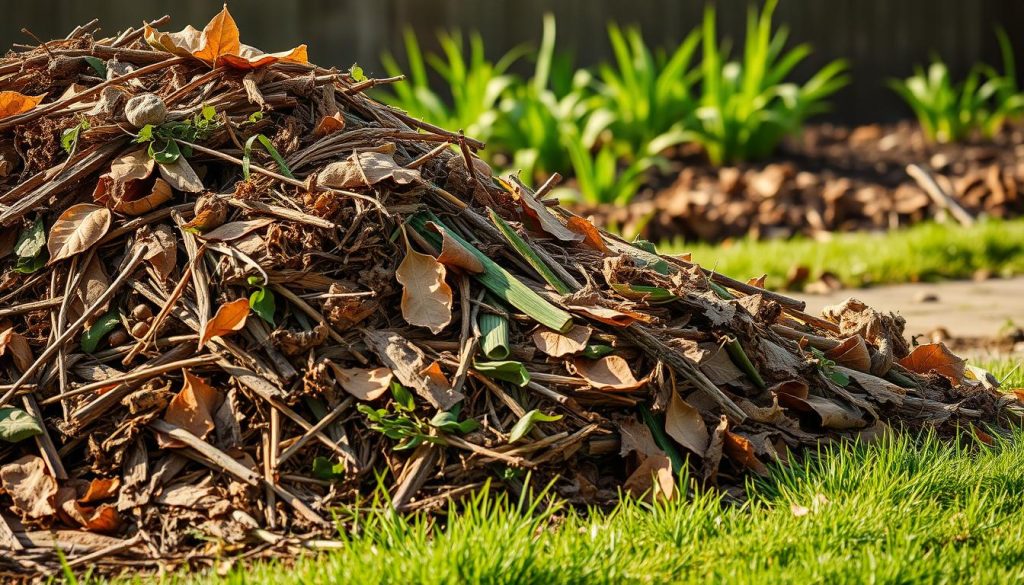
Fallen leaves are the most common “brown” material. They provide essential carbon for compost structure. Small twigs, pine needles, and shredded woody prunings are also browns.
Browns decompose more slowly than greens. They help keep airflow in your compost pile. This prevents it from getting too wet or compacted.
Seasonal Yard Waste Collection Strategies
Smart gardeners have systems for collecting and storing yard waste all year. Fall is the best time to collect and store excess leaves. Use a separate bin or leaf bags for these valuable browns.
In spring and summer, when greens are plentiful, add stored browns. Chipping or shredding larger yard waste speeds up decomposition. It also makes storage more efficient.
By seeing yard maintenance as a chance to harvest, you change how you view leaves and grass clippings. Your garden will thrive from this nutrient cycle. You’ll also enjoy the satisfaction of turning waste into a valuable resource.
The Science Behind Nutrient-Rich Soil from Organic Composting
Every handful of compost is a result of a complex process. It turns simple decomposition into a soil amendment better than synthetic options. This process shows why composting is key for our gardens.
Macro and Micronutrients in Compost
Compost gives plants everything they need to grow well. It has nitrogen, phosphorus, and potassium, the “big three” nutrients. Nitrogen helps leaves grow, phosphorus strengthens roots, and potassium boosts overall health.
Compost also has micronutrients like calcium and zinc. These are often missing in chemical fertilizers but are vital for plants. The nutrients in compost are released slowly, giving plants steady nourishment.
Soil Structure Improvement
Composting changes soil structure. It makes soil better at holding water, helping plants grow. In clay soils, it improves drainage. In sandy soils, it helps retain water.
This change also makes soil more aerated. Roots can get more oxygen, leading to healthier plants. This balance is hard to achieve with synthetic fertilizers.
Biological Activity Enhancement
Compost brings life to your soil. A teaspoon of quality compost has billions of beneficial microbes. These microbes help plants absorb nutrients better.
They also fight off harmful pathogens, keeping soil healthy. This ecosystem breaks down organic matter, feeding plants continuously. Compost turns your garden into a self-sustaining environment.
Adding compost to your garden is more than just feeding plants. It introduces a living soil ecosystem. This is what makes composting better than synthetic fertilizers, which don’t build living soil.
Different Methods of Organic Composting for Home Gardeners
Organic composting offers many methods for different spaces and preferences. The right method helps you keep composting, reducing waste and enriching soil. Let’s look at the best ways to turn household waste into garden gold.
Traditional Pile Composting
Creating a pile in your yard is simple and free. But, it needs space and regular care to work well.
Three-Bin Systems
A three-bin system is a step up from piles. It lets you manage different stages of decomposition at once. The first bin is for fresh stuff, the middle for partially broken down, and the last for finished compost.
Layering Techniques
Good pile composting needs the right layering. Mix:
- Brown materials (carbon-rich): dried leaves, cardboard, newspaper
- Green materials (nitrogen-rich): kitchen scraps, fresh grass clippings
- Thin layers of soil or finished compost for microbes
- Occasional water to keep it moist like a sponge
Bin and Tumbler Systems
Bin systems are neater, keep pests out, and compost faster. They hold heat and moisture better.
Stationary Bins
These bins protect from weather and smells. They’re easy to use and fit medium yards. They compost in 3-6 months, depending on how you manage them.
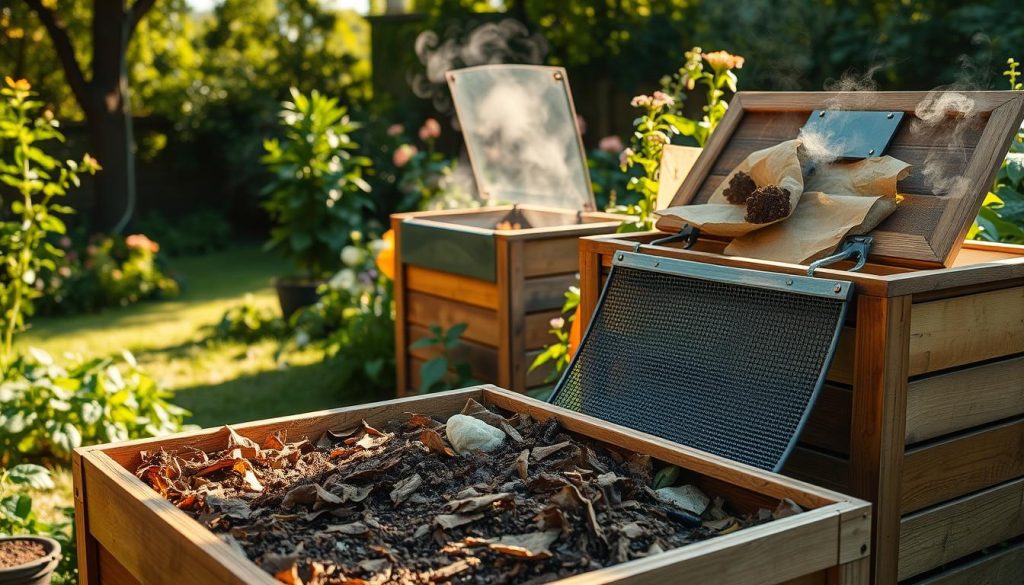
Tumbler systems make mixing easy by rotating. This speeds up composting, often in 4-8 weeks. They’re pricier but great for quick results with less work.
Vermicomposting with Worms
Vermicomposting uses worms to quickly break down food scraps. It makes nutrient-rich worm castings that boost plant growth. Worm bins are perfect for small spaces or indoor composting.
A good worm bin has little smell and can handle 2-3 pounds of waste weekly. The compost it makes is full of microbes and hormones for plant growth.
Bokashi Fermentation
Bokashi is a Japanese method that ferments waste without oxygen. It can handle meat, dairy, and oils. It uses special bran with microbes in sealed buckets.
After 2-4 weeks, the fermented mix needs 2-4 weeks in soil to fully decompose. This makes bokashi great for city dwellers who can bury it in community gardens.
Setting Up Your First Compost System
Starting your composting journey is exciting. You’ll need a system that fits your needs. With some planning and basic tools, you can turn waste into garden gold. The right setup makes composting efficient and fun.
Location Considerations
Finding the perfect spot for your compost bin is key. Look for a spot that’s level, drains well, and gets some sun. Too much sun can dry it out, while too little shade slows it down.
It’s also important to pick a spot that’s easy to get to. This way, you can easily add to it from your kitchen and garden. For city dwellers, make sure it’s at least 2 feet away from neighbors and buildings for good airflow.
Think about how you’ll get to it all year. A bin that’s hard to reach in winter or spring can mess up your routine. Many people make a path to their bin so they can use it all year.
Size and Container Options
The size of your bin depends on your household and garden. A bin that’s 3’×3’×3′ is usually right for a family of four and a medium garden.
You can choose from DIY or store-bought bins. A wire mesh bin is cheap and good for yard waste. Plastic tumblers are more expensive but faster. Wooden pallet bins are a good choice for airflow and are affordable.
If you live in an apartment, there are smaller options. Bokashi systems or small vermicomposting bins are great for small spaces. They handle food waste quickly without needing outdoor space.
Essential Tools and Equipment
You don’t need to spend a lot to compost. A few basic tools make it easier. A garden fork or aerator helps mix and speed up the process.
A kitchen container with a filter keeps smells away while you collect scraps. Pruning shears and a tarp are useful for yard waste. A compost thermometer helps beginners keep track of temperatures.
Many household items can be used for composting. An old salad bowl is great for scraps, and a repurposed trash can is a good starter bin.
Troubleshooting Common Composting Challenges
Learning to compost can be a bit tricky, but it’s very forgiving. Most problems have easy fixes. Knowing how to solve common issues will keep your compost system healthy and productive.
Dealing with Odors
A good compost pile smells earthy and nice, not bad. If it smells bad, it’s telling you something’s off.
An ammonia smell means too much nitrogen. Just add more brown materials like leaves or newspaper to balance it out.
A rotten egg smell means your pile lacks oxygen. Turn it more often and add twigs to improve airflow.
Managing Pests
Pests can be a big problem for composters. Here are some natural ways to keep them away:
- Bury food scraps in the center of your pile, not on top
- Don’t add meat, dairy, or oils that pests love
- Use a bin with a tight lid to keep pests out
- Surround your pile with hardware cloth to stop burrowing
- Top with dry leaves or finished compost after adding scraps
Addressing Slow Decomposition
Slow decomposition can be due to several reasons. The main one is an unbalanced carbon-to-nitrogen ratio. Aim for 3 parts brown to 1 part green.
Smaller pieces decompose faster. So, chop or shred big materials before adding them.
Temperature also matters. In cold weather, decomposition slows down. Use straw or a black bin to keep it warm.
Balancing Moisture Levels
Right moisture is key for composting. It should be damp, like a wrung-out sponge.
If it’s too wet, add dry materials and mix it well. A wet pile can get smelly and anaerobic.
For a dry pile, add water slowly while mixing. You can also use green materials like grass clippings to add moisture.
Composting is both art and science. Every challenge you solve makes you better at creating great compost for your garden.
Seasonal Composting: Year-Round Practices
Keeping your compost pile active all year requires adjusting your methods with the seasons. Composting isn’t just for growing seasons. With the right strategy, you can keep your composting system going all year. This way, you’ll always have nutrient-rich compost for your garden when it needs it most.
Spring and Summer Composting Activities
Spring and summer are when you get lots of green materials for composting. Grass clippings, fresh prunings, and veggie garden waste are perfect for quick decomposition. These warmer months make your compost pile heat up and break down faster.
To keep balance, have some brown materials like dried leaves or shredded paper ready. Add these carbon-rich materials after green waste to avoid odors and ensure decomposition.
Watch moisture levels in hot weather. Your pile might need more water as it gets warmer. Turn your compost often in summer to keep it aerated and prevent wet materials from matting. This is also a good time to take out finished compost for your garden beds.
Fall and Winter Composting Strategies
Fall is great for collecting carbon-rich materials for composting all year. Fallen leaves are composting gold. Shred them before adding or store them in bags for slow addition through winter and spring.
In colder areas, decomposition slows in winter but doesn’t stop. Make your pile at least three cubic feet to keep it warm. Insulate your compost bin with straw bales or cardboard to keep microbes active in the cold.
Keep adding kitchen scraps in winter, burying them in the pile’s center where it’s still active. Even in cold months, chop materials small to speed up decomposition. By composting all year, you’ll have compost ready for spring planting.
Applying Finished Compost in Your Garden
Composting’s magic unfolds when you use the finished compost in your garden. After weeks or months of work, your compost is ready to nourish your plants and improve the soil. This dark, crumbly material is a perfect mix of recycled nutrients that plants love. It’s key to eco-friendly gardening.
Top Dressing Existing Plants
Top dressing is easy. Just spread a layer around your plants without harming their roots. For veggies, add a 1-inch layer every few months during growing season. Perennials get a 2-inch layer in spring, and shrubs and trees need a 3-inch layer up to their drip line.
The best time for top dressing is early spring or fall. It slowly releases nutrients, protects roots, and cuts down on water loss.
Amending Soil for New Plantings
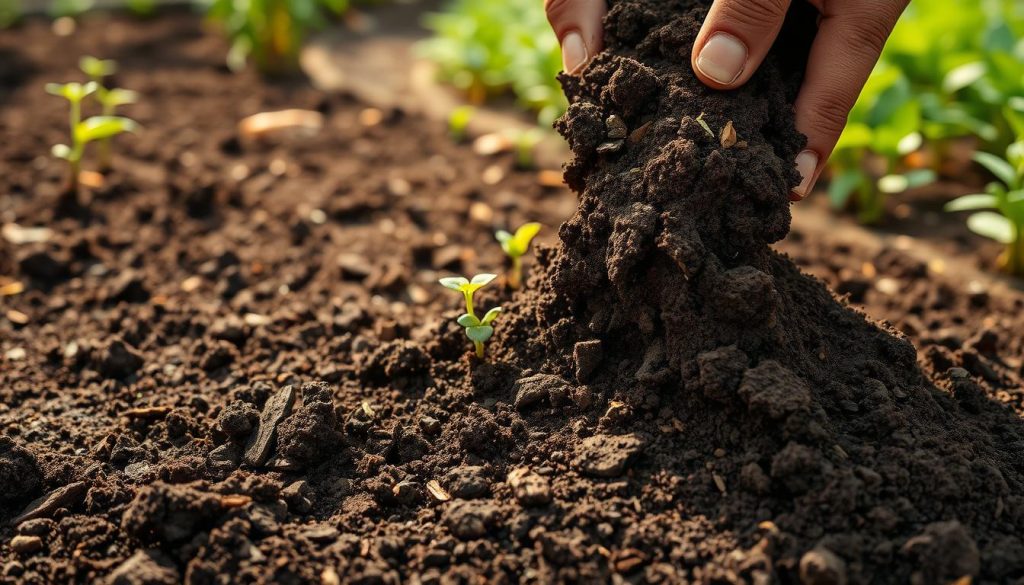
Compost is a powerful soil improver for new beds or planting holes. Mix it with native soil at these ratios for best results:
- Vegetable gardens: 30-40% compost to 60-70% soil
- Flower beds: 25-30% compost to 70-75% soil
- Tree and shrub planting: 20% compost mixed with soil in a hole twice the root ball width
This mix improves soil structure, helps with drainage, and boosts water retention. It also gives new plants a nutrient boost for quick growth.
Creating Compost Tea
Compost tea is a liquid fertilizer full of beneficial microbes. It’s great for quick nutrient uptake and fighting diseases. You can apply it directly to plants or soil.
Brewing Methods
There are many ways to make compost tea, from simple to complex:
Application Techniques
Use these methods to apply compost tea for the best results:
| Application Method | Best For | Frequency | Benefits |
|---|---|---|---|
| Foliar Spray | Leafy vegetables, flowers | Every 2-3 weeks | Disease resistance, nutrient absorption |
| Soil Drench | Trees, shrubs, perennials | Monthly | Root development, soil biology |
| Seed Soak | Seeds before planting | Once before sowing | Germination rates, seedling vigor |
| Transplant Solution | New plantings | At planting time | Reduced transplant shock, faster establishment |
Join the Organic Composting Revolution: Your Garden and Planet Will Thank You
Starting your organic composting journey is more than just a gardening activity—it’s a powerful step toward sustainable living. Every banana peel and coffee ground you rescue from the trash creates nutrient-rich soil. This soil helps your plants thrive without chemical fertilizers.
The beauty of composting lies in its simplicity. Nature already knows how to break down organic matter—we just create the right conditions. Your compost pile connects you to ancient farming wisdom while addressing modern environmental challenges.
Think beyond your garden fence too. Share extra compost with neighbors, swap tips at community gardens, or help start a neighborhood composting program. These connections build resilient communities centered around sustainable practices.
Each composting household diverts hundreds of pounds of waste from landfills yearly. This small action reduces methane emissions and returns valuable nutrients to the soil instead of sealing them away in plastic bags.
Ready to begin? Start small with kitchen scraps in a simple bin. As you watch your first batch of compost transform into dark, rich soil, you’ll experience the satisfaction of completing nature’s cycle in your own backyard.
By embracing organic composting, you join thousands of gardeners creating healthier soils, stronger plants, and a more sustainable world—one compost pile at a time. Your garden will reward you with abundant harvests, and our planet will benefit from your care.

